Experience the rich tradition of Puerto Rican Pasteles (Pasteles Puertorriqueños), an immersion of flavors in every bite and indulgence in the magic of family, heritage, and festive delight!

Making pasteles during the holiday season is a cherished and heartwarming experience that goes beyond the culinary aspect. It is a time-honored ritual that brings together generations, creating a tapestry of love, connection, and cultural pride.
Just like Pernil Asado (Roasted Pork Shoulder), Arroz con Gandules (Pigeon Peas and Rice), and Empanadas de Yuca are traditional dishes served for Christmas, so are pasteles. It’s a beautiful and delicious tradition we hold dearly during the holidays. Celebrations kick off in early December and gracefully extend beyond the 25th of December. For countless Puerto Ricans, the spirit of Christmas lingers until the second week of January, concluding with the final celebration known as the “Octavitas.” It’s undeniably a magical and extended Christmas season for us!
Jump to:
What are Pasteles?
Pasteles are meat-filled patties made out of root vegetables and green cooking bananas to make a masa. The dough is layered on top of banana leaves, pasteles paper (or parchment paper), wrapped with butchers twine and then boiled. They’re also known as pasteles de guineo and pasteles de masa.
Are Pasteles Hard to Make?
While some individuals shy away from making pasteles, believing them to be challenging, labor-intensive, or hindered by ingredient limitations, that doesn’t have to be the reality.
Unless you’re aiming to make 30-50 dozen pasteles the process is neither excessively demanding nor complicated. Additionally, if you cannot find certain ingredients, our pasteles recipe provides other alternatives to suit your needs. This recipe yields 20 delicious pasteles.
Reasons to Love this Pasteles
- Culinary Delight: Puerto Rican pasteles are a culinary masterpiece. The combination of seasoned meat, flavorful masa, and the unique touch of plantain leaves creates a taste sensation that is both savory and truly satisfying!
- Cultural Heritage: Each bite of a Puerto Rican pastel is a connection to the rich cultural heritage of the island. The traditional ingredients, preparation methods, and the act of coming together to make pasteles represent a living link to Puerto Rican history.
- Family Tradition: Making pasteles is not just about the end result; it’s about the process and the shared experience. Families often come together to prepare pasteles during the holiday season, creating lasting memories and strengthening bonds. The tradition of making pasteles is a beautiful expression of love, unity, and just being together.
- Versatility: Whether it’s Pasteles de Masa (also known as Pasteles de Guineo or just Pasteles), Pasteles de Yuca, or Empanadas de Yuca, the versatility of Puerto Rican pasteles allows for a variety of flavors and options. The ability to customize the fillings and masa to personal preferences adds a unique touch to this beloved dish.
- Extended Celebration: Puerto Rican pasteles are not just a one-day affair. They are often enjoyed throughout the extended holiday season, contributing to the festive atmosphere that lasts well beyond December 25th. The tradition of savoring pasteles extends into the New Year, bringing joy and celebration for a more prolonged period!
Ingredients to Make the Masa for Pasteles

- Green Cooking Bananas – Green cooking bananas are not the same as green plantains but instead bananas that haven’t been gassed.
- Yautia or Malanga – If you live in a Hispanic area, you should be able to find in your local supermarket otherwise check a specialty Latin or purchase online.
- Calabaza (Kabocha Pumpkin) – The pumpkin not only adds flavor but also helps to keep the masa soft.
- Batata (White Sweet Potato) – optional to add.
- Achiote Oil – The achiote (Annatto) oil gives color to the pasteles.
- Broth from Carne para Pasteles (Pork Filling) – reserve 1-2 cups of the broth. Adds flavor to the masa and helps to make it softer.
- Adobo – Season to taste.
*See my recipe card below for a complete list of the ingredients with measurements and instructions.*
Ingredients for the Pork Filling

- Pork – Use pork shoulder or butt.
- Garlic – Use fresh garlic or garlic puree for the best flavor.
- Oregano and Bay Leaves – Both are very important aromatic ingredients to this filling.
- Sazon – Use sazon with annatto for both flavor and color.
- Adobo and Sofrito – Adds both seasoning and true authentic Puerto Rican flavor.
- Garbanzo Beans (Chickpeas) – Usually used in the pasteles filling but excluded from the empanadas de yuca filling.
- Pimiento Morrones (Roasted Red Bell Peppers) – An ingredient I couldn’t imagine not using in my meat filling!
- Achiote Oil (Annatto Oil) – adds flavor and color to the meat.
*Follow my recipe for Carne Para Pasteles to see a full list of ingredients with measurements and instructions to make the pork filling. It’s easy to put together and cooks in an hour.
To Assemble the Pasteles
- Frozen Banana Leaves
- Pasteles Paper or Parchment Paper
- Butchers Twine
- Masa de Guineo
- Pork Filling
- Achiote Oil
- Chickpeas
- Jarred Roasted Bell Peppers
- Extra Pimiento Stuffed Olives
*See my recipe card below for a complete list of the ingredients with measurements and instructions.*
Substitutions and Variations
What if I Can’t Find Green Bananas?
- Unless you live in a Hispanic area, finding green cooking bananas in your local supermarket, could be a little challenging. However, if you have a specialty Latin or Asian market near you, you can usually find them there. Otherwise, substitute the green bananas with 6 large green plantains.
Where Can I Find Calabaza (Kabocha Pumpkin/Squash)?
- Depending on where you live, you should be able to find it in your local supermarket. Otherwise, substitute with butternut or acorn squash.
What other Root Vegetables Can I Use for this Recipe?
- You can also use yuca instead of the malanga or yautia.
What Other Filling Can I Use?
- You can replace the pork filling with chicken.
Instructions
Step 1: Begin with making the achiote (annatto) oil and meat filling for the pasteles. Follow our Achiote Oil recipe and our Carne Para Pasteles (Pork Meat Filling) recipe post to make.

Step 2: Using a knife, cut the stem ends off of each banana. Carefully make a slit in the front and back of each banana (Image 1). Add the bananas to a large mixing bowl or pot and top with hot water. Allow them to soak in the water to help soften the peels while you work with the other vegetables.
Using a potato peeler or knife, peel the skin off the yautia and pumpkin (Image 3).
Cut them into large chunks and set aside.
Peel the bananas and leave them whole. Add the bananas and other vegetables to another pot or bowl with cold water.
Note: Adding the peeled bananas into cold water will stop them from oxidizing and turning brown.
Use a food processor with the grater attachment (Image 4) to grate the bananas and vegetables or alternatively use a box grater.

Step 3: Grate all the bananas and vegetables (Image 5). You will notice some large chunks left behind on top of the grater attachment that weren’t grated. Set these aside and pour the masa into a large bowl or baking tin. Remove the attachment and replace it with the metal blade attachment. Add all the large chunks left behind with about a cup of the masa (Image 6) and puree for 30 seconds (Image 7).
Step 4: Use a large spoon to stir the masa and combine well. The masa should be light, and airy (Image 8).

Step 5: Add about ½ cup of the achiote (annatto) oil and about two cups of the pork broth to the masa (Image 9). Using a large spoon slowly stir and start to blend in the oil and the broth into the masa to combine well. Add about 3 teaspoons of adobo to the masa and stir.
Taste a small amount of the masa to check for salt, add more adobo or salt if needed.
Note: Do not add too much adobo or salt as the pasteles cook in salted water.
Prepare Your Pasteles Work Station
Gather all your ingredients to assemble the pasteles. These will include the pasteles paper (or parchment paper), butchers twine, banana leaves, masa, pork filling, chick peas, olives, pimiento strips and achiote oil (Image 11).
Cut, Prepare the Banana Leaves, Paper and Twine
Step 1: Cut 20 pieces of twine so that each piece measures 40 inches. Set aside.
Step 2: If using parchment paper instead of pasteles paper, cut 20 sheets to measure 18-inch by 12-inch rectangles.
Step 3: Cut the banana leaves to measure about 7 ½ inches by 6 ½ to 7 ½ inches. Using scissors, cut the rough rib or edge (Image 12) off.

Frozen Banana Leaves
Add the cut leaves to a bowl with warm soapy water, swirl the leaves with your hand and then rinse each leaf individually under warm water. Wipe both sides of the leaves with a clean damp kitchen towel or paper towels (Image 13).
Fresh Banana Leaves
Rinse the cut leaves under warm water. Wipe both sides of the leaves with a clean damp kitchen towel or paper towels (Image 13). Using a pair of tongs, pass the leaves one at a time on both sides over your gas stove’s high flame for a few seconds. The leaves will start to wilt, this is normal. Set aside.
Assembling the Pasteles
Step 1: Lay a banana leaf in the center of the pasteles (parchment) paper and spread a teaspoon of the achiote oil or a teaspoon of the pork broth to the center of the leaf (Image 14).
Step 2: Scoop ½ cup of the masa to the center of the leaf and spread it into an oval. Fill the masa with about 2 to 3 tablespoons of the pork filling. Top the meat with two or three chickpeas, two or three olives and two to three pimiento strips (Image 15).
Wrapping the Pasteles

Step 1: Fold the bottom of the paper over so that the ends meet. Using your hand, tuck the filling snuggly into the center (Image 1). Make a one inch fold at the top of the parchment paper (Image 2) and then fold over the pastel (Image 3).
Flatten out the sides, one side at a time (flaps) well and then tuck under the pastel (Image 4).

Repeat the process with the other side and then tuck the side under again (Image 5).
Repeat the entire process and make the other pasteles. Once you have all the pasteles formed and wrapped, proceed to stack them into bundles and tie.
Preparing Pasteles Bundle
Stack two pasteles on top of each other with the folded (tucked) ends touching each other (Image 6) to create a bundle, (known as a yunta).
Tying Pasteles
Grab a cut piece of the twine and place under the bundle, cross the strings (Image 6), flip over and cross the string over (Image 7).
Flip over again and loop over again on one side of the pastel (Image 8).

Repeat the process on the other end and tie the bundle (Images 9 and 10).
How to Cook and Serve Pasteles
In a large pot, add enough water to cover pasteles. Bring to a boil. Sprinkle about a teaspoon of salt to the water and add the amount of pasteles you want to cook.
Cook for one hour (Image 11). Remove the pasteles from the pot draining the excess water from them. Lay on a cutting board or serving plate and cut the strings using scissors or knife (Image 12).

Carefully spread open the sides (flaps) and either cut the sides with scissors or leave them whole.
Start to open the parchment paper (Image 15) to reveal the pastel and serve (Image 16). Top with hot sauce or ketchup if desired.
Note: Trimming the edges with scissors eases serving on a plate, especially if you prefer serving pasteles with parchment paper and banana leaf. Alternatively, leave the parchment intact or remove pasteles to serve directly on a plate.

Expert Cooking Tips
- Taste – Once the masa is prepared, sample a small amount on your finger to ensure it’s not bland. If needed, add more adobo or salt to enhance the seasoning.
- Salt – Don’t forget to add salt to the water the pasteles are cooked in. Otherwise, the pasteles will taste a little bland.
- Banana Leaves – If you cannot find frozen banana leaves, use double parchment paper to prepare the pasteles.
Recipe FAQs
If the pasteles are cooked immediately after their preparation, cook for 1 hour.
Cook frozen pasteles 75 to 90 minutes.
The majority of individuals favor pasteles that are tender, soft, and possess a slight creaminess. On the flip side, some prefer a firmer texture. The outcome largely depends on the ingredients incorporated into the masa. The addition of pumpkin and yautia to the banana masa, along with the broth, contributes to a softer consistency.
Store your pastele bundles (yuntas) in freezer-safe plastic bags for up to months.
Use lentils and vegetables. Here is a recipe by Popsugar for vegan pasteles.
Did you try this recipe? Please leave a ⭐ review below!
Click any of the images in the post to PIN this Recipe and don’t forget to follow along on Pinterest and Facebook.
Other Popular Holiday Dishes
📖 Recipe
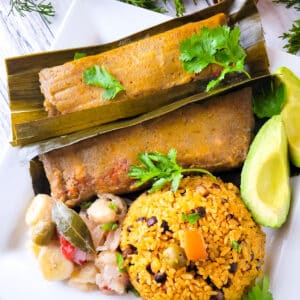
Puerto Rican Pasteles (Pasteles Puertorriquenos)
Equipment
- food processor or box grater
- butcher's twine
- Pasteles paper or parchment paper
- frozen or fresh banana leaves
Ingredients
To Make the Pork Filling
To Make the Masa
- 12 green cooking bananas peeled
- 2 lbs yautia peeled and cut into large chunks
- 1 lb calabaza (kabocha squash) peeled and cut into large chunks
- 1 large batata (white sweet potato) optional (I did not use in this version of pasteles)
- 1½ cups achiote oil
- 2 cups pork broth from the stewed pork filling
- adobo to taste
To Assemble the Pasteles
- 1 package frozen banana leaves thawed
- achiote oil
- masa de guineo (banana puree)
- pork filling
- pasteles paper or parchment
- butcher's twine
- pimiento stuffed olives
- chickpeas
- pimiento morrones (roasted pepper strips)
Instructions
- Begin with making the achiote (annatto) oil and meat filling for the pasteles. Follow our Achiote Oil recipe and our Carne Para Pasteles (Pork Meat Filling) recipe post to make.
Making the Masa
- Using a knife, cut the stem ends off of each banana. Carefully make a slit in the front and back of each banana. Add the bananas to a large mixing bowl or pot and top with hot water. Allow them to soak in the water to help soften the peels while you work with the other vegetables.
- Using a potato peeler or knife, peel the skin off the yautia and pumpkin.Cut them into large chunks and set aside.
- Peel the bananas and leave them whole. Add the bananas and other vegetables to another pot or bowl with cold water.Note: Adding the peeled bananas into cold water will stop them from oxidizing and turning brown.
- Use a food processor with the grater attachment to grate the bananas and vegetables or use a box grater.
- Grate all the bananas and vegetables. You will notice some large chunks left behind on top of the grater attachment that weren't grated. Set these aside and pour the masa into a large bowl or baking tin. Remove the attachment and replace it with the metal chopping blade attachment. Add all the large chunks left behind with about a cup of the masa and puree for 30 seconds.
- Use a large spoon to stir the masa and combine well. The masa should be light, and airy.
- Add about ½ cup of the achiote (annatto) oil and about two cups of the pork broth to the masa. Using a large spoon slowly stir and start to blend in the oil and the broth into the masa to combine well.
- Add about 3 teaspoons of adobo to the masa and stir. Taste a small amount of the masa to check for salt, add more adobo or salt if needed.Note: Do not add too much adobo or salt as the pasteles cook in salted water.
Cut Prepare the Banana Leaves, Paper and Twine
- Cut 20 pieces of the twine so that each piece measures 40 inches. Set aside.
- If using parchment paper instead of pasteles paper, cut 20 sheets to measure 18-inch by 12-inch rectangles.
- Cut the banana leaves to measure 7 ½ inches by 6 ½ to 7 ½ inches.
- Using scissors, cut the rough rib or edge off.
- Frozen Banana LeavesAdd the cut leaves to a bowl with warm soapy water, swirl the leaves with your hand and then rinse each leaf individually under warm water. Wipe both sides of the leaves with a clean damp kitchen towel or paper towels (Image 13).Fresh Banana LeavesRinse the cut leaves under warm water. Wipe both sides of the leaves with a clean damp kitchen towel or paper towels (Image 13). Using a pair of tongs, pass the leaves one at a time on both sides over your gas stove’s high flame for a few seconds. The leaves will start to wilt, this is normal. Set aside.
- Set up your workstation to include the pasteles paper (or parchment paper), butcher's twine, banana leaves, masa, pork filling, chickpeas, olives, pimiento strips and achiote oil.
Assembling the Pasteles
- Lay a banana leaf in the center of the pasteles (parchment) paper and spread a teaspoon of the achiote oil or a teaspoon of the pork broth to the center of the leaf.
- Scoop ½ cup of the masa to the center of the leaf and spread it into an oval. Fill the masa with about 2 to 3 tablespoons of the pork filling. Top the meat with two or three chickpeas, two or three olives and two to three pimiento strips.
Wrapping the Pasteles
- Fold the bottom of the paper over so that the ends meet. Using your hand, tuck the filling snuggly into the center. Make a one-inch fold at the top of the parchment paper and then fold over the pastel.
- Flatten out the sides, one side at a time (flaps) well and then tuck under the pastel.
- Repeat the process with the other side and then tuck the side under again.Repeat the entire process and make the other pasteles. Once you have all the pasteles formed and wrapped, proceed to stack them into bundles and tie them.
Preparing Pasteles Bundle
- Stack two pasteles on top of each other with the folded (tucked) ends touching each other to create a bundle, (yunta).
Tying Pasteles
- Grab a cut piece of the twine and place it under the bundle, cross the strings, flip over and cross the string over.Flip over again and loop over again on one side of the pastel.*Refer to post images for additional help.
- Repeat the process on the other end and tie the bundle.
How to Cook and Serve Pasteles
- Fill a large pot with enough water to cover the pasteles. Bring it to a boil, then sprinkle approximately a teaspoon of salt (or a bit more) into the water. Add the desired quantity of pasteles to cook.
- Cook for an hour. Remove pasteles from the pot, draining excess water. Place on a cutting board or serving plate, and cut the strings using scissors or a knife.
- Open the sides (flaps) and either cut the sides with scissors or leave them whole.
- Open the parchment paper to reveal the pastel and serve.Top with hot sauce or ketchup if desired.Note: Cutting the sides with scissors makes it more comfortable to serve on a plate if you are wanting to serve the pasteles inside the parchment paper and banana leaf. Alternatively, you can either leave the parchment paper whole or remove the pastel completely and serve on a plate without the parchment paper.
Notes
Nutrition


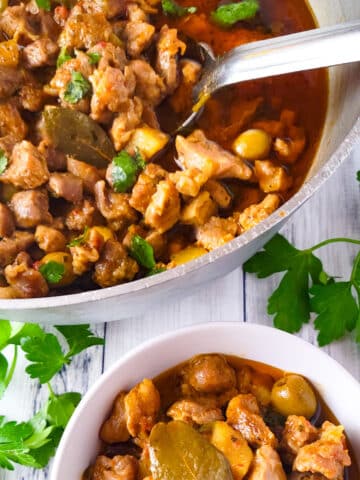
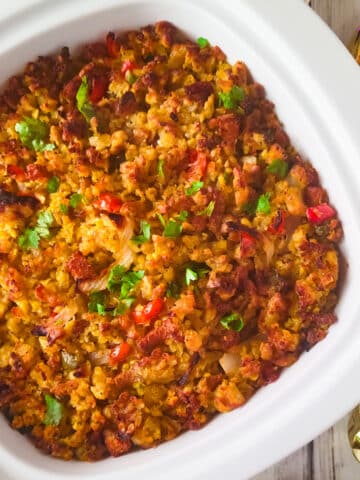
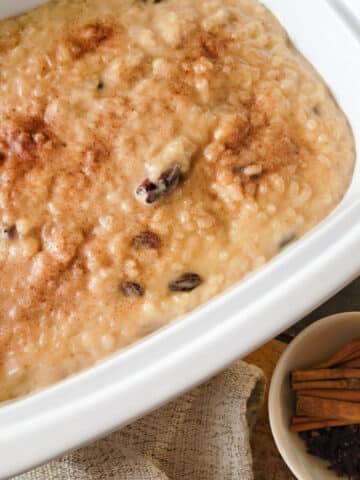
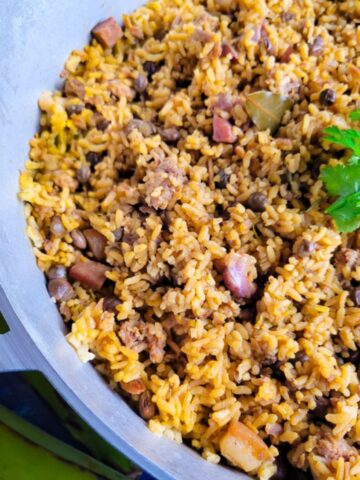

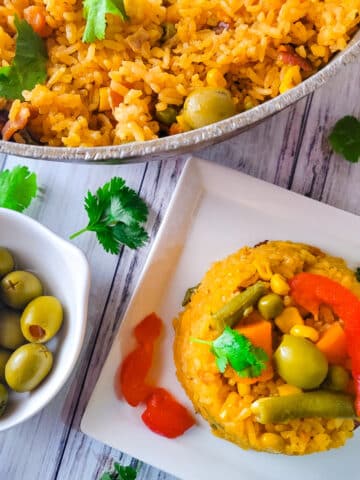
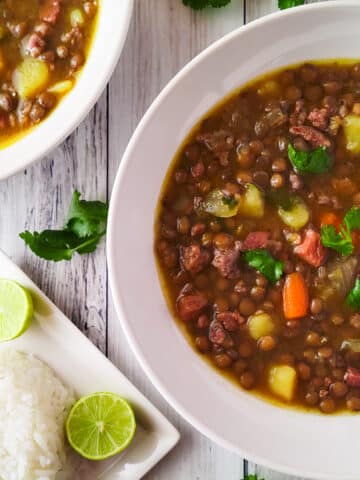
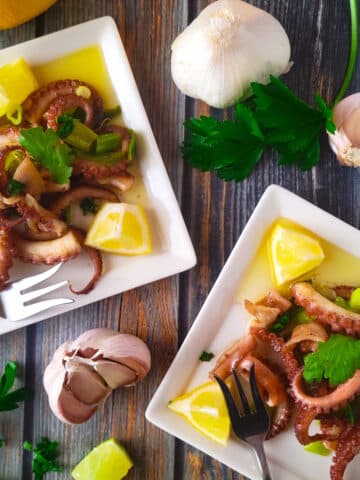

Margie says
If you don’t have a gas stove to wilt the banana leaves what other ways can you do that?
Catherine Arena says
Hi Margie! If you’re using frozen banana leaves, there is no need to wilt the leaves. Simply defrost, cut to size, add them to a mixing bowl with warm soapy water, swirl them with your hand and then rinse each individual leaf under warm water. Then wipe each leaf on both sides with a kitchen towel or paper towels, proceed with the recipe. Wilting only applies to fresh banana leaves. If you are using fresh banana leaves, cut, rinse under warm soapy water, rinse again, dry on both sides and then wilt over an open flame. If you do not have a gas stove, heat them for a few seconds in the microwave to make them pliable. You can also use a barbecue grill. Thank you for your question, I hope this helps! 🙂